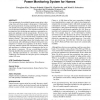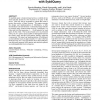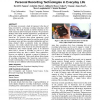HUC
2009
Springer
14 years 5 months ago
2009
Springer
This paper attempts to re-imagine ubiquitous computing for populations in low-income and information-challenged environments. We examine information infrastructures in midsized ur...
HUC
2009
Springer
14 years 5 months ago
2009
Springer
Detecting visits to semantically meaningful places is important for many emerging mobile applications. We present PlaceSense, a place discovery algorithm suitable for mobile devic...
HUC
2009
Springer
14 years 5 months ago
2009
Springer
A key prerequisite for residential energy conservation is knowing when and where energy is being spent. Unfortunately, the current generation of energy reporting devices only prov...
HUC
2009
Springer
14 years 5 months ago
2009
Springer
To usefully query a location-based service, a mobile device must typically present its own location in its query to the server. This may not be acceptable to clients that wish to ...
HUC
2009
Springer
14 years 5 months ago
2009
Springer
Future homes will be populated with large numbers of robots with diverse functionalities, ranging from chore robots to elder care robots to entertainment robots. While household r...
HUC
2009
Springer
14 years 5 months ago
2009
Springer
HUC
2009
Springer
14 years 5 months ago
2009
Springer
HUC
2009
Springer
14 years 5 months ago
2009
Springer
Recent work has examined infrastructure-mediated sensing as a practical, low-cost, and unobtrusive approach to sensing human activity in the physical world. This approach is based...
HUC
2009
Springer
14 years 5 months ago
2009
Springer
This paper introduces a sensing garment to support posture coaching in children. The system measures back bending postures using acceleration sensors embedded in the garment. We p...
HUC
2009
Springer
14 years 5 months ago
2009
Springer
In this paper, we present a study of responses to the idea of being recorded by a ubicomp recording technology called SenseCam. This study focused on real-life situations in two N...




